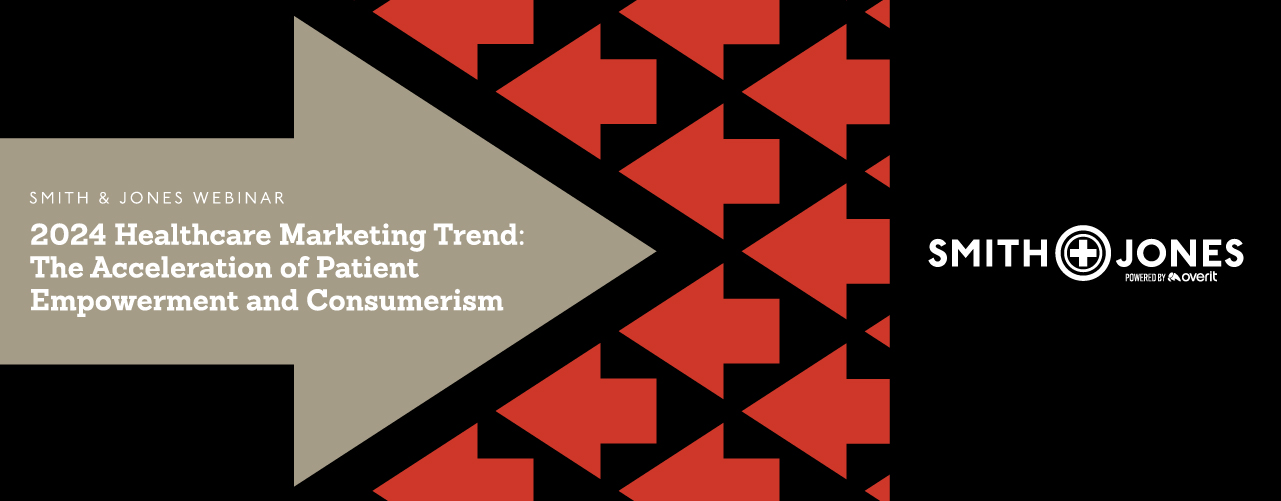2024 Healthcare Marketing Trend: The Acceleration of Patient Empowerment and Consumerism – Recap
To kick off our 2024 Healthcare Marketing Trends Webinar series, we started with Trend #1: The Acceleration of Patient Empowerment and Consumerism. VP Paul and Content Strategist Katie broke down the factors fueling consumerism, how technology and information empower patients, and the implications and takeaways for marketers.
Watch the full webinar on our YouTube Channel, or keep reading for a quick overview!
Knowledge is Power
The rise of the internet over the last 30 years has democratized access to health information, empowering patients to take control of their healthcare decisions. The launch of WebMD in 1998 proved to be a turning point, as it was the first time patients could easily search for and understand potential diagnoses based on their symptoms. This marked a significant shift from relying solely on physicians’ expertise to patients having access to information that could inform their healthcare decisions.
Now, the rise of social media has further fueled patient empowerment. Platforms like TikTok have become tools for sharing personal health experiences and spreading knowledge. This peer-to-peer sharing of information has created a community where patients can learn from each other, fostering a sense of empowerment and control over their healthcare decisions.
Another factor to consider is patients seeking out reviews and recommendations online. Gen X and younger are likely to Google a doctor’s name or healthcare location before making an appointment, and reviews (or lack thereof) could be a make-or-break moment. For more information on this topic, check out our webinar, The Future of Consumer Reviews for Healthcare Organizations.
Show Me the Money
The shift towards high-deductible health plans has also played a significant role in the rise of patient empowerment and consumerism. These plans require patients to pay a significant amount of their medical expenses before their insurance plan starts to cover costs. This shift has placed a layer of financial risk on patients, making them more conscious of the cost of their healthcare and demanding price transparency.
Companies like Walmart, known for their “always low prices” mantra, are stepping into the healthcare space, bringing with them a philosophy of price transparency. In Walmart Health centers, patients can see a price list for various services, providing information that is often lacking in traditional healthcare settings.
The good thing is, that most hospitals are now making an effort to comply with the CMS Hospital Price Transparency Rule, which went into effect in 2021. 70% of hospitals complied with both components in 2022, up from just 27% in 2021. CMS reportedly fined 12 hospitals in 2023. Remember, this information must be “consumer-friendly,” meaning the average person can easily understand the information presented to them. This is why plain language (our Trend #3!) is so important. If you’re putting information out, but it’s not clear to the person reading, it’s not helpful. Marketing should be in the room to review content and give recommendations.
Implications for Marketers
The confluence of patient empowerment and consumerism has far-reaching implications for healthcare marketers. Let’s break it down.
- Patient-Centric Marketing: Healthcare marketers must pivot their strategies to focus on patient-centered approaches. Tailoring communications and services to meet individual patient needs, preferences, and values will be crucial.
- Consider testimonials (video and written), educational content, and interactive and responsive tools such as chatbots or instant messaging.
- Digital Engagement: As patients increasingly use digital tools and platforms to manage their health, healthcare marketers should invest in digital engagement strategies, including telehealth marketing and online communities.
- Make sure all your web content is optimized for mobile as more people are browsing information or booking appointments on the go.
- Make sure email communication is customized to the individual’s interests and preferences.
- Transparency and Trust: Emphasizing transparency in pricing and outcomes data will be vital in a consumer-driven healthcare environment. Building trust through clear, honest communication is key. The first step to this is education through video, webinars, and related tools.
- Include a dedicated section online (and in print brochures) for pricing and billing policies.
- Make sure to have transparency in data reporting from third-party sources, especially outcomes!
- Messaging Your Innovation: Healthcare marketers should emphasize innovative technologies and services available, especially how they improve patient outcomes and experiences. From valet parking to robotics, these are all part of an empowered consumer’s expectations.
- Feature patient stories and case studies.
- Host virtual tours and webinars so people can learn about locations/services and feel comfortable.
- Data Privacy and Security: Healthcare marketers must prioritize data privacy and security in their marketing campaigns and practices to maintain patient trust as healthcare becomes more data-driven.
- Publish data privacy policies online and promote them at webinars or on social media when appropriate.
- Make sure to stay on top of HIPAA digital marketing regulations.
As traditional healthcare business models evolve to meet these challenges, healthcare marketers must adapt their strategies accordingly. Healthcare marketers have a unique opportunity to lead the charge in delivering patient-centric, value-driven healthcare experiences, ultimately benefiting patients and the industry as a whole.
Download our full 2024 Healthcare Marketing Trends Report here!

